- Home
- Orson Scott Card
Galaxy's Edge Magazine Page 15
Galaxy's Edge Magazine Read online
Page 15
This book is most recommended for all mystery readers, contemporary fantasy/horror readers, and anyone who wants to read a really enjoyable mystery that follows FBI procedures written by someone who has lived them. We do hope the real FBI’s office politics aren’t as bad as Kimble presents them.
* * *
Black Chamber
by S.M. Stirling
Ace
July, 2018
ISBN-13: 978-0399586231
An alternate history with strong steampunk elements, Black Chamber takes us from the moment that Teddy Roosevelt won the presidency after the tragic and premature death of William Howard Taft and Vice President Sherman declining to assume the office by reason of illness. Once in office, Roosevelt made sweeping changes that would not have surprised his contemporaries or later biographers. Modern technology is encouraged and supported, creating jobs and raising the standard of living for everyone in the United States. Roosevelt also supported universal suffrage and equal rights for minorities, themes that are expanded greatly in this novel. Protection and oversight of social change is discussed and overseen by his private cabinet of security officials, the Black Chamber.
The United States does not exist in a vacuum, however. Those scientific advances aren’t unique to the US and its allies. Powers such as Germany consider the upstart across the Atlantic needs to be struck down so that they can conquer the weaker neighbors on their doorstep. Rumors have reached the Black Chamber of a powerful weapon. To discover the details, a young and beautiful spy has been dispatched, Roosevelt’s own goddaughter, Luz O’Malley Arostegui.
Highly trained in skills and disciplines that one could picture being used by Emma Peel or Modesty Blaise, and with broad sexual tastes, Luz infiltrates the source of the weapon. It is even more horrible than she had been led to understand. With the help of a female ally she meets in the castle where the weapon is being prepared, Luz must try to protect the United States from widespread death and destruction. Black Chamber is a terrific adventure, hard-hitting where it needs to be, with moments for tender romance and a solid dose of feel-good patriotism. Recommended for those who like a good spy story, steampunk, and nail-biting adventure.
* * *
Vallista
by Steven Brust
Tor Books
October, 2017
ISBN-13: 978-0765324450
This recommendation is both a review and our classic for the column. Vallista is the latest book in the Jhereg series. Jhereg and its sequels are the story of Vlad Taltos, an accomplished assassin and thief. His missions tend to involve him, to his definite frustration, in literally world-changing events. His world is unique, filled with magic, and its history tends to run in dramatic cycles. In the present cycle, the long-lived Dragaerans dominate; in another it had been the magically-talented Isolla. Vlad is an Easterner, basically a human. He is accompanied by two intelligent and poisonous small dragons who are not above commenting on Vlad’s mistakes. House Jhereg is licensed to control all of the organized crime. Vlad’s missions tend to put him at odds with it, so as of the beginning of Vallista he has a price on, or rather for, his head.
A friend, the daughter of a god and a world-warping wizard, is trapped in a time—and place-shifting castle. This may be because of her own magical origins. She appeals to Vlad to save her from it. He plunges into a castle where taking a few steps can send you to another room or two hundred years into the past. There, amid a range of hostile monsters, mages, and servants, he has to solve the mystery of the place to free his friend.
The strength of all the Jhereg books is in Steven Brust’s writing. It is wordsmithing and tale telling of the highest order. The books are also great fun to read, and the cynical and deadly main character immensely appealing. He is just about the ultimate rogue. If you have already discovered the series, we don’t have to tell you to rush out and get Vallista. Anyone else who reads fantasy novels should start from the beginning and give yourself the pleasure of enjoying the entire series.
* * *
The Brightest Fell
by Seanan McGuire
DAW Books
September, 2017
ISBN-13: 978-0756413316
Continuing the bestselling October Daye paranormal fantasy mystery series, The Brightest Fell opens with Toby celebrating her bachelorette party ahead of her wedding with Tybalt, King of the Cats (Cait Sidhe). All seems normal, if you factor in that the party was organized by her own Fetch, May Daye (if you don’t like horrible puns, stop here), and the guests include a host of mythological creatures and shapeshifters. Among the guests singing karaoke and getting plastered, even Toby, whose half-fae metabolism sheds liquor in a matter of minutes, manages to enjoy herself. When she returns home, full of good spirits, the worst of all possible visitors arrives on her doorstep seeking Toby’s help to solve a missing persons case: her mother Amandine. More than reluctant to open any of the cans of worms presented to her, Toby is plunged into the world of the fae in search of her half-sister, August. Fast-moving in an intricately drawn world full of fascinating creatures, hard philosophical choices, and wry humor, The Brightest Fell is a worthy addition to the October Daye series. Recommended for fans of paranormal fantasy and urban fantasy. If you have not read any of these before, McGuire includes enough background information for this volume to stand alone, but it will leave you eager to seek out the rest.
* * *
The Complete Sookie Stackhouse Stories
by Charlaine Harris
Ace Books
November, 2017
ISBN-13: 978-0399587597
If you’re a fan of the Sookie Stackhouse novels (brought to video in the HBO television series True Blood), you need this volume to supplement your collection. Over the years, Charlaine Harris has contributed short stories about telepathic waitress of the small town Bon Temps, Louisiana, Sookie Stackhouse, to anthologies co-edited by Harris with her friend and colleague Leigh Perry.
Each of these stories is told in the first person by Sookie. Here, Harris has the leisure to expand upon the personal stories of characters that her readers have come to know and love or fear (or both) in her novels. From the first, “Fairy Dust,” about fairies Claude, Claudine, and their triplet Claudette, to the last, “In the Blue Hereafter,” you’ll find the same solid storytelling you’ve come to expect from Harris. Her personal favorite, “Two Blondes,” involves Sookie and 160-year-old vampire friend on a road trip to a casino in Mississippi. Every tale is a gem. You can binge-read the volume, but it’s better to savor it one story at a time. Recommended for fans of the Sookie Stackhouse novels, as well as serving as an introduction to new readers who might want to sample Harris’s writing before committing to whole novels.
TOR MINIS: An Announcement
In the mail, we received the first six of these. They certainly fit into a column full of the new and different, not to mention one’s paperback bookshelf. TOR Books is coming out with a new book format, something that has not happened since Pocket Books introduced the paperback novel in 1939. (Many then predicted those new-fangled paperback books would be the doom of publishing.) TOR Minis are mass market—sized hardcover novels. The covers and paper are hardcover quality. The smaller pages make the books a bit thicker than a normal hardcover book or trade paperback, but they are much shorter and narrower than even some other paperback-sized books. The price point is around fifteen dollars, halfway between a $7.99 paperback and a $24.99 hardcover. Their size makes these books convenient to carry or read in a crowded space such as on a jet or subway, and will fit more easily into a jacket pocket or purse. For people who still love the feel of a paper book, you’ll be able to keep your favorite TOR book with you.
Copyright © 2018 by Bill Fawcett and Jody Lynn Nye
Gregory Benford is a Nebula winner and a former Worldcon Guest of Honor. He is the author of more than thirty novels, six books of non-fi
ction, and has edited ten anthologies.
A SCIENTIST’S NOTEBOOK
by Gregory Benford
HUMANITY AS CANCER
“... still I have not seen the fabulous city on the Pacific shore. Perhaps I never will. There’s something in the prospect southwest from Barstow which makes one hesitate. Although recently, driving my own truck, I did succeed in penetrating as far as San Bernardino. But was hurled back by what appeared to be clouds of mustard gas rolling in from the west on a very broad front. Thus failed again. It may be however that Los Angeles will come to me. Will come to all of us, as it must (they say)to all men.”
EDWARD ABBEY
Desert Solitaire
In 1960 the journal Science published a short paper which is still sending slow-motion shock waves through the soothsayers of our time. Titled “Doomsday: Friday, 13 November, A.D. 2026,” its abstract reads in full, “At this date human population will approach infinity if it grows as it has grown in the last two millennia.”
Period. Its authors, Heinz van Foerster, Patricia Mora and Lawrence Amiot, were members of the staff of the department of electrical engineering at the University of Illinois, Urbana. They were not population experts, but they noted a simple oddity of mathematics. The rise in human numbers was always studied in “doubling times”, the measure of how quickly population doubled. But real human numbers don’t follow so clean an equation.
For a species expanding with no natural limitation aside from ordinary deaths, the rate of increase of population is proportional to the population itself. Mathematically, the population N is described by an equation in which the change in N, dN, over a change in time t, dt, obeys
dN/dt = b N
with b usually assumed to be a constant. If b is truly constant, then N will rise exponentially.
Fair enough. But if people are clever, the proportionality factor b itself will weakly increase as we learn to survive better. This means the rate of increase will rise with the population, so N increases faster than an exponential.
In fact, it can run away to infinity in a finite time. The equation describing this is a bit more complicated. To find how b changed with N, the authors simply looked at the average increase over the last two thousand years to iron out bumps and dips, seeking the long-term behavior.
They found a chilling result. Our recent climb in N in the last few centuries is not an anomaly; instead, it fits the smooth curve of human numbers. Tracking the solution backward “post-dicts” that we were a mere 200,000 people a million years ago. Of course such great spans aren’t well fit by population counts gathered from two millennia, and the equation becomes silly. But it should be good for at least a few centuries more.
Looking into the near future, it predicts a chilling result: a singularity, with N rising faster and faster, going beyond view on November 13, 2026. “The clever population annihilates itself,” they remark laconically. “Our great-great-grandchildren will not starve to death. They will be squeezed to death.”
The paper has never been refuted. Further checks on the growth of the factor b have pushed the singularity date further away, to about 2042. This is comforting, moving the date by about twenty years in the thirty-four years since the paper appeared.
But the general conclusion stands. As an exercise in statistics it is stimulating, and as far as I know the authors did little with it after their first telling point.
Of course, nothing grows to the sky. Something will happen before b gets too large; the four horsemen of the apocalypse will ride again. Perhaps they already are. Still, we are not doormats. We are attempting population control, but results are slow, and pressures are mounting.
I wrote before in this column about the ideas which follow, in an piece titled “The Biological Century.” I’d like to revisit an idea I floated there, with some second thoughts.
* * *
The future is coming, and it’s ugly.
Or so many believe. From staid university presidents and scruffy environmentalists alike, a growing consensus holds that humanity has entered a watershed era, a time of vast disasters looming large, just over the horizon of this generation. Their case rests on far more than an equation too.
In 1992 I went on a cross-country hike in Orange County to protest a highway soon to go in. Puffing up a hill, I struck up a conversation with a member of the eco-warrior group Earth First, who wore the signature red shirt with a clenched fist. We mounted a ridge and saw the gray sweep of concrete that lapped against the hills below.
“Looks like a sea of shit,” the Earth Firster said. “Or a disease.”
That same month the National Academy of Sciences and Britain’s Royal Society jointly warned of the dangerous links between population and environmental damage. Following this up, the Union of Concerned Scientists mustered 1,500 experts to sign a “World Scientists’ Warning to Humanity” and published it in leading newspapers. Heavy hitters, these, including the predictable (Linus Pauling, Paul Ehrlich, Carl Sagan), the inexpert but sanctified (Desmond Tutu), but also the heads of many scientific societies, Nobel Laureates, and authorities of many fields. One such Laureate, Henry Kendall of M.I.T., is leading the New Cassandras in a campaign to rouse the intelligentsia.
His case is easy to make. World population grows by ninety million yearly and will double within half a century, if trends continue—which seems unlikely, with the United Nations estimating a saturation at nine billion. More people have been born in the last forty years than in the previous three million years. About eight percent of all human beings ever born live today. We are gaining at about 1.7 percent a year.
Meanwhile, the Green Revolution is apparently over: world per-capita crops have declined. About ten percent of the Earth’s agricultural land area has been damaged by humans. Water may be the first major resource to go; half of all nations now have water shortages. Even in the American Midwest and Southwest, farmers are sucking “fossil water” laid down in the ice ages, pulling it from aquifers which will deplete within a generation.
But such policy-wonk numbers, the ecologists remind us, are too human-centered. Our swelling numbers have their greatest impact on defenseless species in rain forests, savannahs and coral reefs. Biologist E.O. Wilson of Harvard warns that we could lose thirty percent of all species within half a century, and that might be only the beginning.
Humans exert selective pressures on the biological world. North Atlantic waters show a clear pattern of over-fishing, and ever-shrewd nature has filled these new niches with “trash fish” like skates and spiny dogfish which we cannot eat and thus do not take out.
Monocluture crops worldwide gain efficiency by growing the same staple—wheat, rice, corn, trees—over a large area, but this is inherently more fragile. Diseases and predators prey easily and already erosion is a major threat in many such areas.
Environmental damage grows not merely because our numbers rise, but because our expectations do too. The masses jammed into Buenos Aires want a better life—which means more consumer goods. The chain between such ambitions and the clearing of distant forests is, though long, quite clear.
Most environmentalists are technophobic, reluctant to admit that the greatest enemy of the rain forests is not Dow Chemical but rather sunburned, ambitious men newly armed with chain saws, eager to better their lot in life.
Still, hand-wringing is not new and skepticism about it is well earned. Paul Ehrlich’s alarmist “The Population Bomb” has yet to explode twenty-five years after publication, though some demographers feel that Ehrlich may simply be a few decades off.
And there are counter-trends. Many are laboring to see that the factor b does not increase.
The “developing world”—to use the latest evasive tag attempting to cover societies as diverse as Singapore and Somalia—is the great engine of population growth, but its pattern is not an exponential runaway. Taken all together, the poorer natio
ns’ growth rates seem to have reached a plateau.
This may echo the industrial world, whose net growth curve broadly peaked around 1900 at a rate of about one percent a year and is now a fourth of that. The poor countries may have entered just such a transition era. Some nations began peaking in the 1970s and others join them. Still, the plateau average rate is 2.5 percent per year, so they have a long way to fall.
Will they decline? Environmentalists and professors alike fear they won’t.
Our numbers respond to both feedback loops and to feed-forward anticipations. Gloom, doom—well known intellectual commodities, finding a perpetual market.
The 1960 paper is still the firmest basis for hand-wringing. Few experts believe the planet can sustain a population doubling in parallel with rising economic desires. This is how the Earth Firsters merge with the academics—a profoundly pessimistic view of our collective future, shared from the hushed halls of Harvard to the jerky hip-hop images of MTV.
This sea change we already see in severe cultural collision, such as immigration. MIT’s Kendall predicts a doubling of Mexico’s immigration into the USA within a decade. Shantytowns along the USA southwestern border recall the slums of Rio. Last year the USA added 970,000 new legal immigrants, plus 132,000 refugees and the INS estimates that slightly over a million illegal immigrants came to stay. Our growth rate is nearly a one percent per year. Since our native population is near the zero population growth level so publicized in the 1970s, this means immigration is virtually the sole cause of US growth, and places us far ahead of other industrial nations.

 Shadows in Flight
Shadows in Flight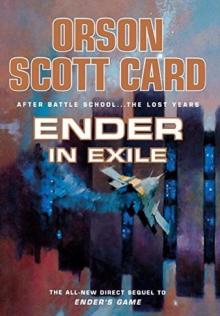 Ender in Exile
Ender in Exile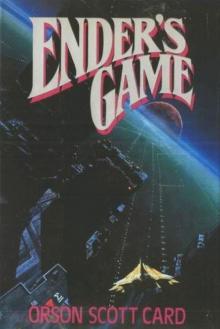 Ender's Game
Ender's Game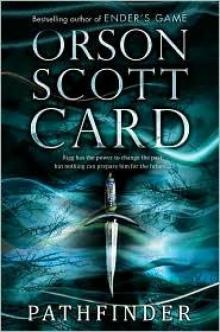 Pathfinder
Pathfinder Children of the Fleet
Children of the Fleet Children of the Mind
Children of the Mind Ruins
Ruins Speaker for the Dead
Speaker for the Dead Ender's Shadow
Ender's Shadow Folk of the Fringe
Folk of the Fringe Hart's Hope
Hart's Hope Shadow of the Giant
Shadow of the Giant Empire
Empire Shadow Puppets
Shadow Puppets Earth Afire
Earth Afire First Meetings in Ender's Universe
First Meetings in Ender's Universe Maps in a Mirror: The Short Fiction of Orson Scott Card
Maps in a Mirror: The Short Fiction of Orson Scott Card Xenocide
Xenocide The Swarm: The Second Formic War
The Swarm: The Second Formic War Saints
Saints Seventh Son: The Tales of Alvin Maker, Volume I
Seventh Son: The Tales of Alvin Maker, Volume I Zanna's Gift
Zanna's Gift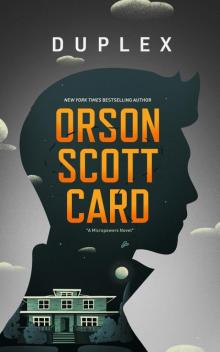 Duplex
Duplex Zanna's Gift- a Life in Christmases
Zanna's Gift- a Life in Christmases Hidden Empire
Hidden Empire Earth Awakens
Earth Awakens Visitors
Visitors Shadow of the Hegemon
Shadow of the Hegemon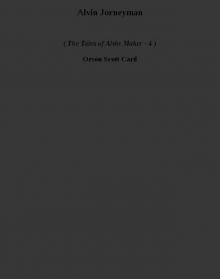 Alvin Jorneyman ttoam-4
Alvin Jorneyman ttoam-4 Federations
Federations The Gate Thief mm-2
The Gate Thief mm-2 First Meetings
First Meetings Capitol
Capitol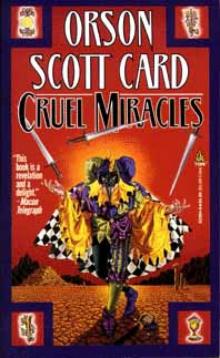 Cruel Miracles
Cruel Miracles Shadows in Flight, enhanced edition
Shadows in Flight, enhanced edition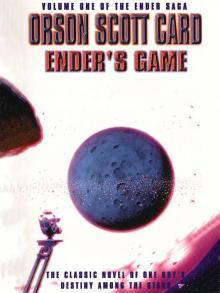 Ender's Game es-1
Ender's Game es-1 Ruins (Pathfinder Trilogy)
Ruins (Pathfinder Trilogy) Ender's Shadow ew-6
Ender's Shadow ew-6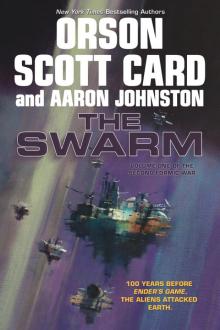 The Swarm
The Swarm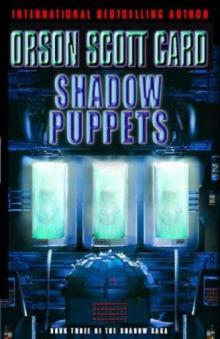 Card, Orson Scott - Ender's Saga 7 - Shadow Puppets
Card, Orson Scott - Ender's Saga 7 - Shadow Puppets Lost Boys: A Novel
Lost Boys: A Novel Mazer in Prison
Mazer in Prison Treason
Treason Heal Thyself
Heal Thyself The Call of Earth
The Call of Earth Songmaster
Songmaster Heartfire ttoam-5
Heartfire ttoam-5 Pastwatch
Pastwatch Gatefather
Gatefather The Ships of Earth: Homecoming: Volume 3
The Ships of Earth: Homecoming: Volume 3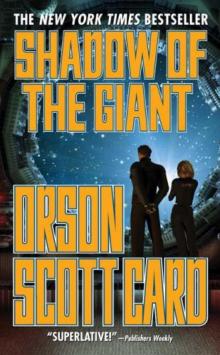 Orson Scott Card - Ender 08 - Shadow of the Giant
Orson Scott Card - Ender 08 - Shadow of the Giant Flux
Flux Speaker for the dead ew-2
Speaker for the dead ew-2 Grinning Man
Grinning Man Ruins sw-2
Ruins sw-2 Earth Unaware
Earth Unaware The Worthing Saga
The Worthing Saga Earthfall (Homecoming)
Earthfall (Homecoming) Card, Orson Scott - Ender's Saga 5 - Ender's Shadow
Card, Orson Scott - Ender's Saga 5 - Ender's Shadow The Abyss
The Abyss Magic Street
Magic Street Masterpieces
Masterpieces Prentice Alvin ttoam-3
Prentice Alvin ttoam-3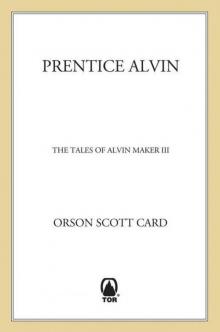 Prentice Alvin: The Tales of Alvin Maker, Volume III
Prentice Alvin: The Tales of Alvin Maker, Volume III Card, Orson Scott - Ender's Saga 3 - Xenocide
Card, Orson Scott - Ender's Saga 3 - Xenocide Homeless in Hell
Homeless in Hell Red Prophet: The Tales of Alvin Maker, Volume II
Red Prophet: The Tales of Alvin Maker, Volume II Earthborn (Homecoming)
Earthborn (Homecoming)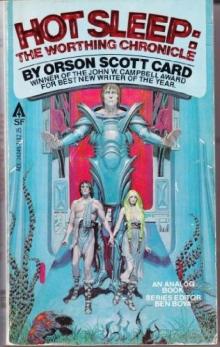 Hot Sleep
Hot Sleep The Hive
The Hive Rachel and Leah (Women of Genesis)
Rachel and Leah (Women of Genesis) Ender's World
Ender's World The Memory of Earth
The Memory of Earth Seventh Son ttoam-1
Seventh Son ttoam-1 Wyrms
Wyrms A Town Divided by Christmas
A Town Divided by Christmas Earth unavare (the first formic war)
Earth unavare (the first formic war) The Shadow of the Hegemon - Orson Scott Card
The Shadow of the Hegemon - Orson Scott Card Earthfall
Earthfall Lost Boys
Lost Boys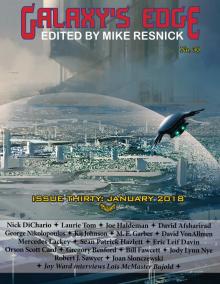 Galaxy's Edge Magazine
Galaxy's Edge Magazine Sarah: Women of Genesis: 1 (Women of Genesis (Forge))
Sarah: Women of Genesis: 1 (Women of Genesis (Forge)) The Crystal City: The Tales of Alvin Maker, Volume VI
The Crystal City: The Tales of Alvin Maker, Volume VI Xenocide ew-4
Xenocide ew-4 Earth Afire (The First Formic War)
Earth Afire (The First Formic War) Maps in a Mirror
Maps in a Mirror Pathfinder sw-1
Pathfinder sw-1 Red Prophet ttoam-2
Red Prophet ttoam-2 THE CRYSTAL CITY
THE CRYSTAL CITY 27 Short Stories
27 Short Stories Heartfire: The Tales of Alvin Maker, Volume V
Heartfire: The Tales of Alvin Maker, Volume V Alvin Journeyman: The Tales of Alvin Maker, Volume IV
Alvin Journeyman: The Tales of Alvin Maker, Volume IV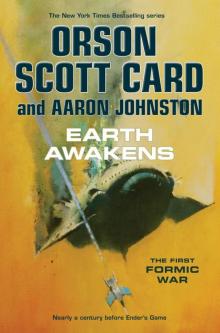 Earth Awakens (The First Formic War)
Earth Awakens (The First Formic War) THE SHIPS OF EARTH
THE SHIPS OF EARTH The Changed Man
The Changed Man Future on Fire
Future on Fire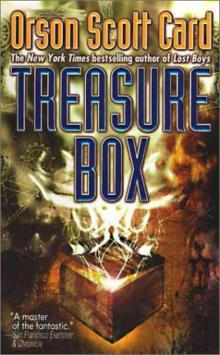 Treasure Box
Treasure Box The Gate Thief
The Gate Thief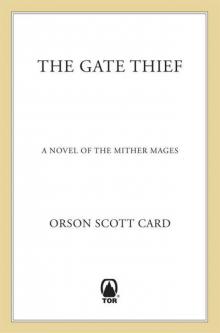 The Gate Thief (Mither Mages)
The Gate Thief (Mither Mages) First Meetings In the Enderverse
First Meetings In the Enderverse Earthborn
Earthborn Seventh Son
Seventh Son Pastwatch: The Redemption Of Christopher Columbus
Pastwatch: The Redemption Of Christopher Columbus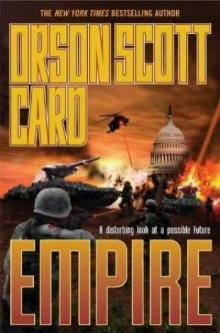 Empire e-1
Empire e-1 Keeper of Dreams
Keeper of Dreams Card, Orson Scott - Ender's Saga 1 - Ender's Game
Card, Orson Scott - Ender's Saga 1 - Ender's Game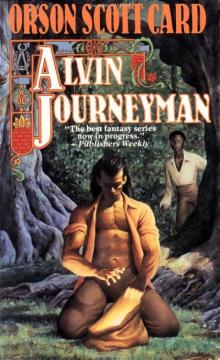 ALVIN JOURNEYMAN
ALVIN JOURNEYMAN The Lost Gate
The Lost Gate Feed The Baby Of Love
Feed The Baby Of Love Hot Sleep: The Worthing Chronicle
Hot Sleep: The Worthing Chronicle